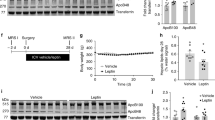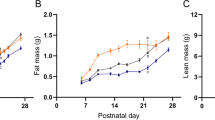Abstract
Objective:
Hypothalamic resistance to the anorexigenic actions of the peripheral adipostat hormone leptin is characteristic of obesity. Here, we use an obese animal model of similar body weight to that of the human to test in vivo whether leptin resistance is due to decreased blood–brain leptin transport or intra-hypothalamic insensitivity, and whether sensitivity to leptin is restored by weight loss. For 40 weeks, adult sheep surgically prepared with intra-cerebroventricular (ICV) cannulae were given a complete natural diet ad libitum (‘Obese’ group) or in restricted quantities (‘Lean’ group), and then the dietary amounts were reversed for 16 weeks until mean group body weights converged (‘Slimmers’ and ‘Fatteners’, respectively).
Results:
ICV leptin injection (0.5 mg) at 8-week intervals acutely decreased voluntary food intake by ∼35% in the ‘Obese’ group on each occasion and in ‘Slimmers’ and ‘Fatteners’ at the end, providing no evidence of intra-hypothalamic insensitivity. The ratio between endogenous leptin concentrations in ventricular cerebrospinal fluid (CSF) and peripheral blood decreased with increasing leptinaemia in ‘Obese’ sheep, indicating decreased efficiency of blood–brain leptin transport, whereas leptin concentrations remained low and the CSF:blood ratio remained high in ‘Lean’ sheep. Compared with ‘Fatteners’ of similar body weight, ‘Slimmers’ were hypoleptinaemic, but their CSF:blood leptin concentration ratio remained low. Thus, the obesity-induced impairment of leptin blood–brain transport was sustained despite an ∼15% weight loss.
Conclusion:
These results support the hypothesis that central resistance to leptin in obesity with associated peripheral hyperleptinaemia is attributable to decreased efficiency of leptin transport into the brain and not to intra-hypothalamic leptin insensitivity. However, leptin transport efficiency is not restored after weight loss by caloric restriction despite the prevailing hypoleptinaemia.
This is a preview of subscription content, access via your institution
Access options
Subscribe to this journal
Receive 12 print issues and online access
$259.00 per year
only $21.58 per issue
Buy this article
- Purchase on Springer Link
- Instant access to full article PDF
Prices may be subject to local taxes which are calculated during checkout




Similar content being viewed by others
References
Ahima RS, Saper CB, Flier JS, Elmquist JK . Leptin regulation of neuroendocrine systems. Front Neuroendocrinol 2000; 21: 263–307.
Burguera B, Couce ME . Leptin access into the brain: a saturated transport mechanism in obesity. Physiol Behav 2001; 74: 717–720.
Ziylan YZ, Baltaci AK, Mogulkoc R . Leptin transport in the central nervous system. Cell Biochem Funct 2009; 27: 63–70.
Banks WA . The blood-brain barrier as a cause of obesity. Curr Pharm Des 2008; 14: 1606–1614.
Morris DL, Rui L . Recent advances in understanding Leptin signaling and Leptin resistance. Am J Physiol Endocrinol Metab 2009; 297: E1247–E1259.
Caro JF, Kolaczynski JW, Nyce MR, Ohannesian JP, Opentanova I, Goldman WH et al. Decreased cerebrospinal-fluid/serum leptin ratio in obesity: a possible mechanism for leptin resistance. Lancet 1996; 348: 159–161.
Schwartz MW, Peskind E, Raskind M, Boyko EJ, Porte Jr D . Cerebrospinal fluid leptin levels: relationship to plasma levels and to adiposity in humans. Nat Med 1996; 2: 589–593.
Suzuki M, Ding Q, Muranaka S, Kigure M, Kojima M, Terada M et al. Correlation between body weight (epididymal fat) and permeation rate of serum leptin through the blood-brain barrier (BBB) in male rats aged 8 months. Exp Anim 2008; 57: 485–488.
Oh-I S, Shimizu H, Sato T, Uehara Y, Okada S, Mori M . Molecular mechanisms associated with leptin resistance: n-3 polyunsaturated fatty acids induce alterations in the tight junction of the brain. Cell Metab 2005; 1: 331–341.
Halaas JL, Boozer C, Blair-West J, Fidahusein N, Denton DA, Friedman JM . Physiological response to long-term peripheral and central leptin infusion in lean and obese mice. Proc Natl Acad Sci USA 1997; 94: 8878–8883.
Wadden TA, Considine RV, Foster GD, Anderson DA, Sarwer DB, Caro JS . Short- and long-term changes in serum leptin dieting obese women: effects of caloric restriction and weight loss. J Clin Endocrinol Metab 1998; 83: 214–218.
Jung SH, Park HS, Kim KS, Choi WH, Ahn CW, Kim BT et al. Effect of weight loss on some serum cytokines in human obesity: increase in IL-10 after weight loss. J Nutr Biochem 2008; 19: 371–375.
Miller DW, Harrison JL, Bennett EJ, Findlay PA, Adam CL . Nutritional influences on reproductive neuroendocrine output: insulin, leptin and orexigenic neuropeptide signaling in the ovine hypothalamus. Endocrinology 2007; 148: 5313–5322.
Miller DW, Findlay PA, Morrison MA, Raver N, Adam CL . Seasonal and dose-dependent effects of intracerebroventricular leptin on luteinising hormone secretion and appetite in sheep. J Endocrinol 2002; 175: 395–404.
Russel AJF, Doney JM, Gunn RG . Subjective assessment of body fat in live sheep. J Agric Sci, Camb 1969; 72: 451–454.
Marie M, Findlay PA, Thomas L, Adam CL . Daily patterns of plasma leptin in sheep: effects of photoperiod and food intake. J Endocrinol 2001; 170: 277–286.
Adam CL, Findlay PA, Miller DW . Blood-brain leptin transport and appetite and reproductive neuroendocrine responses to intracerebroventricular leptin injection in sheep: influence of photoperiod. Endocrinology 2006; 147: 4589–4598.
Banks WA, Kastin AJ, Huang W, Jaspan JB, Maness LM . Leptin enters the brain by a saturable system independent of insulin. Peptides 1996; 17: 305–311.
Adam CL, Archer ZA, Findlay PA, Thomas L, Marie M . Hypothalamic gene expression in sheep for cocaine- and amphetamine-regulated transcript, pro-opiomelanocortin, neuropeptide Y, agouti-related peptide and leptin receptor, and responses to negative energy balance. Neuroendocrinology 2002; 75: 250–256.
Heymsfield SB, Greenberg AS, Fujioka K, Dixon RM, Kushner R, Hunt T et al. Recombinant leptin for weight loss in obese and lean adults: a randomized, controlled, dose-escalation trial. JAMA 1999; 282: 1568–1575.
Banks WA, Lebel CR . Strategies for the delivery of leptin to the CNS. J Drug Target 2002; 10: 297–308.
McCarthy TJ, Banks WA, Farrell CL, Adamu S, Derdeyn CP, Snyder AZ et al. Positron emission tomography shows that intrathecal leptin reaches the hypothalamus in baboons. J Pharmacol Exp Ther 2002; 301: 878–883.
Zhang C, Su Z, Zhao B, Qu Q, Tan Y, Cai L et al. Tat-modified leptin is more accessible to hypothalamus through brain-blood barrier with a significant inhibition of body-weight gain in high-fat-diet fed mice. Exp Clin Endocrinol Diabetes 2009. May 26 [Epub ahead of print].
Banks WA, Coon AB, Robinson SM, Moinuddin A, Shultz JM, Nakaoke R et al. Triglycerides induce leptin resistance at the blood-brain barrier. Diabetes 2004; 53: 1253–1260.
Koistinen HA, Karonen SL, Iivanainen M, Koivisto VA . Circulating leptin has saturable transport into intrathecal space in humans. Eur J Clin Invest 1998; 28: 894–897.
Banks WA, Farrell CL . Impaired transport of leptin across the blood-brain barrier in obesity is acquired and reversible. Am J Physiol Endocrinol Metab 2003; 285: E10–E15.
Kalra SP . Central leptin insufficiency syndrome: an interactive etiology for obesity, metabolic and neural diseases and for designing new therapeutic interventions. Peptides 2008; 29: 127–138.
Acknowledgements
We thank the staff of the Duthie Farm for routine daily animal care, the Rowett Bioresources Group for assistance with surgeries, DEXA scanning and veterinary care, Analytical Services for conducting KONElab analyses and Dr Jacqueline Wallace for advice and encouragement throughout this work. The work was financially supported by the Scottish Government Rural and Environment Research and Analysis Directorate.
Author information
Authors and Affiliations
Corresponding author
Ethics declarations
Competing interests
The authors declare no conflict of interest.
Rights and permissions
About this article
Cite this article
Adam, C., Findlay, P. Decreased blood–brain leptin transfer in an ovine model of obesity and weight loss: resolving the cause of leptin resistance. Int J Obes 34, 980–988 (2010). https://doi.org/10.1038/ijo.2010.28
Received:
Revised:
Accepted:
Published:
Issue Date:
DOI: https://doi.org/10.1038/ijo.2010.28
Keywords
This article is cited by
-
Endospanin 1 silencing in the hypothalamic arcuate nucleus contributes to sustained weight loss of high fat diet obese mice
Gene Therapy (2014)
-
Fat sensing and metabolic syndrome
Reviews in Endocrine and Metabolic Disorders (2014)
-
Effect of body mass index reduction on serum hepcidin levels and iron status in obese children
International Journal of Obesity (2010)



